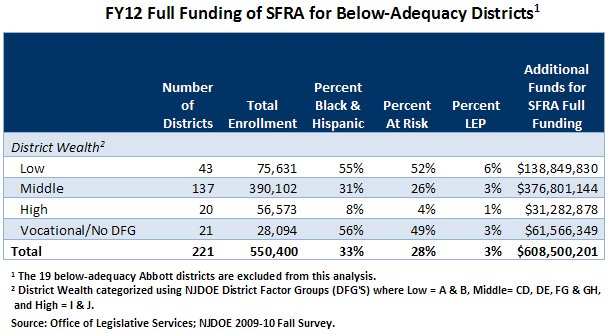FUNDING BELOW-ADEQUACY SCHOOL DISTRICTS: NOT A MOMENT TOO SOON FOR NJ’S AT-RISK STUDENTS
FUNDING BELOW-ADEQUACY SCHOOL DISTRICTS: NOT A MOMENT TOO SOON FOR NJ’S AT-RISK STUDENTS
Newark, NJ — June 8, 2011
According to a June 7 news story, leaders in the New Jersey State Senate may propose increasing state aid in the FY12 State budget in order to fund districts spending below the level determined to be “adequate” under the School Funding Reform Act (SFRA), the State school aid formula.
This proposal comes not a moment too soon. According to an analysis by the nonpartisan Office of Legislative Services (OLS), the number of districts without the funding needed to provide a rigorous, high quality education to all students will grow to 240 next year.
In FY11, 205 districts lacked funds for teachers, programs and services necessary to give all students the opportunity to achieve the NJ “core curriculum” — the education standards adopted by the State in language arts, math, science and other critical subject areas. In FY12, that number will climb to 240, including 19 former Abbott districts, if Governor Christie’s proposed State budget is adopted.
The 221 below-adequacy districts (exclusive of former Abbott districts) serve over 550,000 students — nearly 40% of total enrollment — and are located throughout the state and in every legislative district. The group includes poor and wealthy districts, with the bulk in the moderate- and middle-income categories.

School districts endured state aid cuts of $1.6 billion this year, and the Governor’s proposed budget would continue this under-funding of the SFRA into 2011-12. This would mark the third year that the SFRA, enacted in 2008 with great fanfare, would not be properly funded.
By ignoring State aid levels required by the SFRA formula, the past two State budgets have pushed more and more districts below the adequacy threshold, resulting in cuts to teaching staff, reduced course offerings, increased class size, and the elimination of tutoring, after-school and other academic supports for struggling students.
“More districts below adequacy means many more at-risk children will not receive the programs and services essential to ensure success in school,” said David G. Sciarra, ELC Executive Director. “It’s heartening to see Senators who clearly grasp what this means for schools and students all over the state.”
Sciarra noted that the 17% increase in below-adequacy districts in one year comes on the heels of the NJ Supreme Court decision stating that at-risk students, regardless of where they go to school, are already experiencing significant harm from budget cuts in the current school year.
“As we argued before the Supreme Court, the SFRA should be fully funded for the benefit of all New Jersey schoolchildren,” Sciarra said. “But as many legislators have come to understand, at-risk students in below-adequacy districts certainly need to be assured they will receive the resources they so desperately need to achieve the outcomes we expect and want for them.”
For a detailed list of the 221 below-adequacy districts, including legislative district and county, the percentage of at-risk students in each district, and the amount of additional aid each district will receive under the Senate proposal, click here .
|
Education Law Center Press Contact: |
Press Contact:
Sharon Krengel
Director of Policy, Strategic Partnerships and Communications
skrengel@edlawcenter.org
973-624-1815, x240